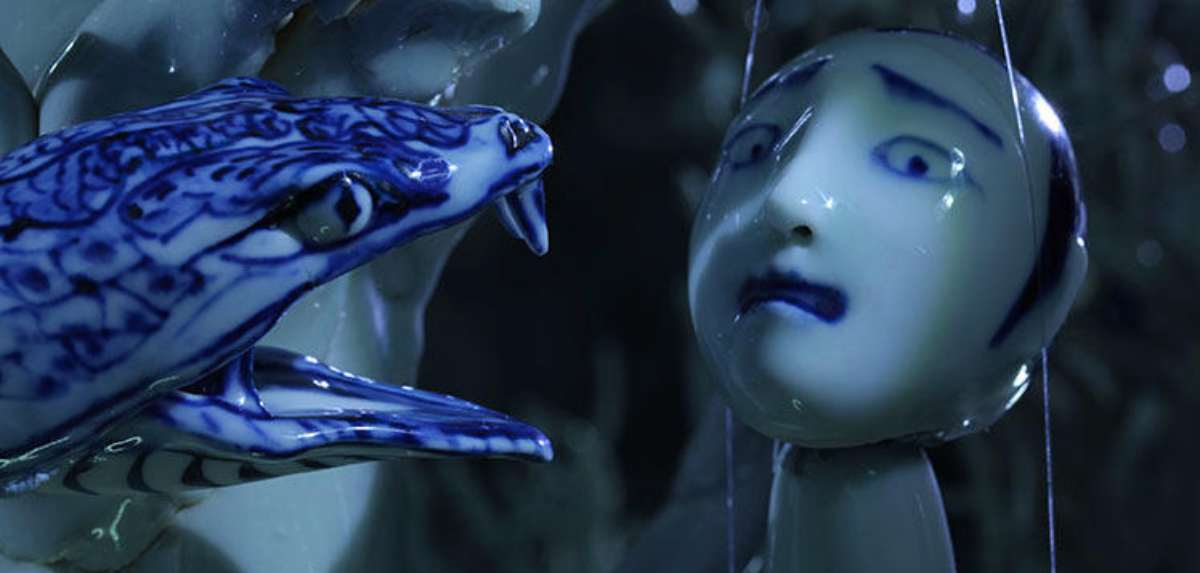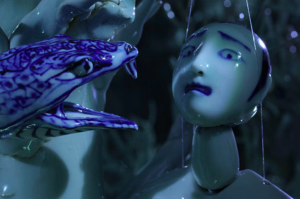by Judith T. Zeitlin
An excerpt from “Reimagining the Ballet Des Porcelaines: A Tale of Magic, Desire, and Exotic Entanglement, edited by Meredith Martin” (Harvey Miller Publishers, 2022).
still image from Geng Xue, Mr. Sea
“The contemporary Chinese artist Geng Xue (b.1983) brings together the many thematic strands of this essay in a short stop-gap animation film of a miniature world composed entirely of blue and white porcelain: trees, figures, flowers, scenic background, all made in Jingdezhen according to her own design, and all lit and shot to enhance the alluring, erotic materiality of porcelain, its luster and reflectiveness, its hardness and fragility. Composed by Wu Huanqing and Wang Jiyu, the film score is interspersed – like Sugar Vendil’s music for the Ballet des Porcelaines – with the haptic sound effects of tinkling, tapping, scratching, and cracking, adding to the visual illusion by immersing us in a sound world of porcelain. The film is based on a seventeenth-century fantastic tale from Pu Songling’s magnum opus Strange Tales from a Chinese Studio. The brief story she chose, “Mr. Sea”, is not a well-known one, but many elements overlap with the Ballet des Porcelaines: an enchanted island, a romance, and an evil sorcerer vanquished (here, a giant porcelain serpent patterned in blue-and-white, the “Mr. Sea” of the title).
Geng Xue harnesses the magic of animation to conjure up a tiny blue-and-white porcelain teapot and cup metamorphosing out of clay to serve the young man after he arrives on the island and then to show the beautiful female inhabitant of the island emerging piece by piece out of a flaming saggar. It is love at first sight. In the midst of their love making, the serpent approaches to claim his victim, and she abruptly smashes into pieces. Struggling for his life as the serpent starts extracting and drinking his blood, the young man finds himself staring at a broken fragment of her face. He drops the fragment along with the poison from a blue-and-white vial into the puddle of red blood at his feet. This kills the serpent but unexpectedly shatters the man to bits. The film ends with a shot of him lying on the seashore “restored to life,’ an intact porcelain figure again. The violent history of porcelain’s creative and destructive powers is once more concealed behind the material’s smooth, shining, beautiful surface.
Geng Xue’s Mr. Sea and Liu Jianhua’s Cup and Bow will be on view at the Smart Museum of Art at the University of Chicago as part of an exhibition on porcelain curated by the art historian Wu Hung. The exhibition is timed to run from February 12-March 6, 2022 in order to overlap with the performances of the Ballet des Porcelaines at the University of Chicago to be held on March 2 and March 3, 2022.”
Judith T. Zeitlin (b. 1958; Chinese: 蔡九迪) is the William R. Kenan Jr. Professor of East Asian Languages and Civilizations at the University of Chicago. Her areas of interest include Ming-Qing literary and cultural history, with specialties in the classical tale and drama.
Selected Publications
- Historian of the Strange: Pu Songling and the Chinese Classical Tale 异史氏:蒲松龄与中国文言小说. Stanford University, 1993
- The Phantom Heroine: Ghosts and Gender in Seventeenth-Century Chinese Literature. University of Hawaii Press, 2007.
- Writing on Walls and the Collection of Women’s Poetry in the Late Ming and Early Qing, translated by Lin Linghan. In “Ming Qing Literature and Gender”, edited by Zhang Hongsheng. Nanjing: Jiangsu Ancient Books Press, 2002: 502-531.
Watch Judith T. Zeitlin’s talk>

